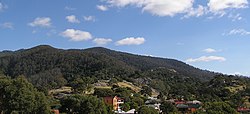Gulaga / Mount Dromedary
Template:WAP assignment



Mount Gulaga (formerly known as Mount Dromedary) is one of the highest mountains on the south coast of New South Wales, Australia. It rises above the village of Central Tilba and is within the Gulaga National Park. At its highest point it is 806 metres above sea level.[1]
Cultural Significance
Gulaga is the place of ancestral origin within the mythology of the Yuin people, the Indigenous Australians of the area. Gulaga itself symbolises the mother and provides a basis for Aboriginal spiritual identity, the mountain as well as the surrounding area holds particular significance for Aboriginal women. The surround area also incorporates Wallaga Lake National Park, land that was given back to the Aboriginal people in May 2006. An agreement was signed by the New South Wales Environment Minister and the Yuin people to solidify the occasion.[2] [3] [4]
The first Europeans to sight the mountain were the crew of Captain Cook's ship, HMS Endeavour on 21 April 1770. Endeavour passed the mountain at a distance of 15 miles (24 km) offshore. Cook named it "Mount Dromedary" as its figure reminded him of the hump of a camel.[5]
Activities
Because Mount Gulaga is a national park it serves as a site for public activity as well as a place of significance for the Aboriginal people. The National Park offers walks along the only mining roads that provide views of the coastal lakes. The hike from Tilba Tilba to the summit is approximately 11km takes about half a day to complete. Though it is steep in a few places along the way, it is a fairly leisurely hike, requiring no special hiking equipment. [6]
Access to the park is approximately 10 kilometres north of Bermagui. The lakes can be accessed by boat. Boats can be rented from Regatta Point or Beauty Point. [7]
The Natural Landscape
When Mount Gulaga was an active volcano over 60 million years ago its peak was 3 kilometres in height. Though it has reduced to 1000 metres it can still be seen from virtually anywhere in the Tilba region and across from many lakes such as Wallaga or Corunna.
Mining
In the mid 1800s Mount Gulaga, then called Mount Dromedary, became a prominent site of gold mining. Rev. W.B. Clarke first found traces of alluvial gold in Dignams Creek that runs from Mount Gulaga in 1852. After that gold mining became a common activity in the area. A significant amount of gold was found in deposits along streams coming from Mount Gulaga's slopes.
References
- ^ "Mt Dromedary gold". Minerals. New South Wales Department of Primary Industries. 1997. Retrieved 2006-05-23.
- ^ http://www.environment.nsw.gov.au/nationalparks/parkHome.aspx?id=N0165
- ^ Foster, Warren (2006). "Gulaga told by Warren Foster". Stories of the Dreaming. Australian Museum. Retrieved 2006-05-22.
{{cite web}}: Cite has empty unknown parameter:|coauthors=(help) - ^ NSW Minister for the Environment, Debus, Bob (2006). "Formal handback of Biamanga and Gulaga national parks to Aboriginal community: Media release - Friday, 3 February 2006". Media releases. Department of Environment and Climate Change. Retrieved 2006-05-22.
{{cite web}}: Cite has empty unknown parameter:|coauthors=(help) - ^ Beaglehole, J.C., ed. (1968). The Journals of Captain James Cook on His Voyages of Discovery, vol. I:The Voyage of the Endeavour 1768–1771. Cambridge University Press. p. 300. OCLC 223185477.
{{cite book}}: Cite has empty unknown parameters:|month=and|coauthors=(help) - ^ http://www.tilba.com.au/gulaga.html
- ^ http://www.environment.nsw.gov.au/nationalparks/parkHome.aspx?id=N0165
36°18′00″S 150°01′30″E / 36.300°S 150.025°E




